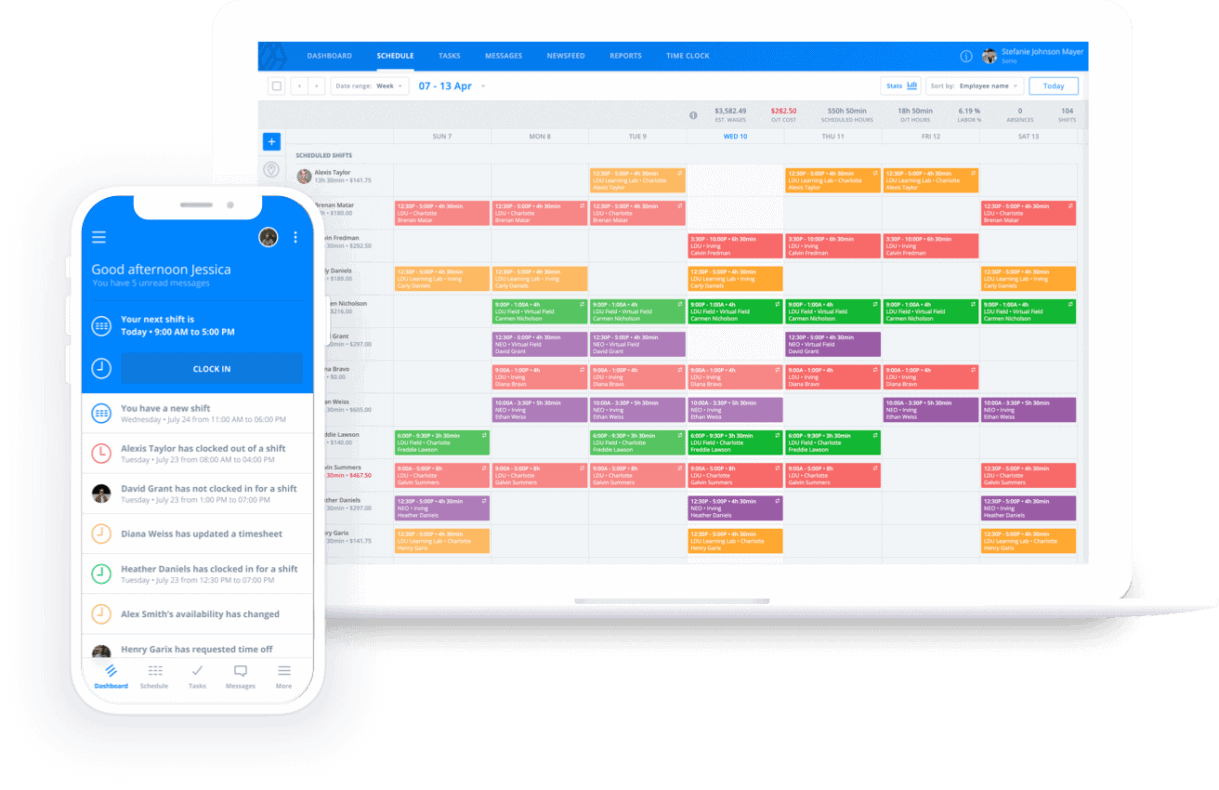Exempt Vs. Non-Exempt Employees: What’s The Difference?
Deciding how to classify exempt vs. non-exempt employees can be confusing at fir...

Employers and employees alike often wonder what the difference is between part-time vs. full-time work schedules. And it really is no wonder because a lot depends on the part-time vs. full-time distinction.
In this article, the experts at Sling show you how the part-time vs. full-time classification affect everything from schedules and pay to benefits and taxes. Before we do that, though, it’s vital that you understand the legal definitions of each category.
In This Article, We Discuss:

In 1940, Congress amended the Fair Labor Standards Act (FLSA) to limit the workweek to 40 hours. This quickly became the standard for defining a part-time vs. full-time work schedule.
Since then, various government departments have defined full-time status differently. For example, the Bureau of Labor Statistics defines “full-time” as 35 hours or more per week. The Affordable Care Act defines “full-time” as averaging 30 hours each week. And the Fair Labor Standards Act doesn’t even touch on numbers but simply states that the provisions apply to both part-time vs. full-time work schedules.
It’s important to understand that none of these definitions is legally binding. The only law on the books is the FLSA amendment that limits the workweek to 40 hours.
Additionally, that doesn’t mean that your employees can’t work more than 40 hours per week. It just means that if they do, they are entitled to overtime.
This gives employers significant freedom to define what full-time means to them. While some employers adhere to the 40-hour workweek as the definition of full-time, others lower that standard to 35, 32, or even 30 hours per week.
A part-time work schedule is one in which an employee works less than full-time. Yes, this is a vague definition, but it serves to illustrate the flexibility you have as an employer to designate what works for your business.
As you’ll see in the next section, a part-time employee is often disqualified from receiving certain benefits, so it’s essential to clearly define part-time vs. full-time according to the needs of your business.
Regardless of how you define your part-time vs. full-time work schedule, it’s crucial that you don’t discriminate. For example, don’t make some of your waiters part-time (and deny them benefits), and other waiters full-time.
Similarly, avoid making all men part-time employees and all women full-time employees (or vice versa). That’s a recipe for legal trouble down the road.
Now that you understand the definition of part-time vs. full-time work, we’ll investigate what makes the two so different.
Part-time work schedules are typically more flexible. One week your employees may work four eight-hour days. Another week, they may work three ten-hour days. They may even work a rotating shift or the night shift if your business needs that.
Because of this flexibility, part-time work schedules are better for those going to school or for those who have another part-time job.
Full-time work schedules, on the other hand, are more stringent. Employees usually work from 8 a.m. to 5 p.m. Monday through Friday. Sometimes, a full-time work schedule is four ten-hour days. Either way, a full-time work schedule demands that an employee be available all week.
Part-time vs. full-time work schedules are distinguished by the number of hours each employee is required to work. If you designate “part-time” as 32 hours or less, that doesn’t mean you have to schedule your part-time employee for the full 32 hours. Some weeks they may work all 32, while other weeks they may work less.
Full-time work schedules usually indicate that the employee will be working at least that many hours. So if “full-time” for your business means more than 32 hours, your full-time employees will be working that number consistently throughout the year.
Rarely does a full-time employee work three twelve-hour days followed by four nine-hour days. Most full-time employees will work a set number of hours Monday through Friday (or Saturday).

Pay is one of the biggest differences between part-time vs. full-time work schedules. And it’s not necessarily about how much each employee is paid (a part-time employee can make just as much as a full-time employee). Rather, it’s about how that pay is calculated.
Part-time employees are most often paid by the hour. So if their pay rate is $10/hour and they work 30 hours in one week, you’ll pay them $300.
Full-time employees can also be paid by the hour, but they are sometimes instead paid a flat salary regardless of the hours worked in a week. So a full-time, salaried employee making $10/hour receives a paycheck for $450 whether they work 40 hours or 45 hours.
Benefits are another major distinguishing factor between part-time vs. full-time work schedules. In general, part-time employees don’t receive benefits, such as health insurance, paid time off, retirement, and stock options.
Most businesses offer their full-time employees a compensation package that includes the above options as well as reimbursements for childcare, education, and fitness.
It’s important to note that benefits vary from employer to employer, and some are even moving toward offering their part-time employees the same benefits as their full-time employees.

Both part-time and full-time employees are taxed in the same way. As an employer, you are required to withhold income taxes and Federal Contributions Insurance Act (FICA) taxes from every employee. You are also responsible for paying unemployment taxes and worker’s compensation benefits.
Many employees consider a full-time job more secure than a part-time job. They see it this way because of the misconception that part-time employees make less money, don’t receive benefits, are less-highly trained, and are easier to replace. This isn’t always true.
Honestly, both part-time and full-time employees can be let go at any time. Neither classification offers more job security than the other.

Hiring part-time employees has a direct effect on your bottom line because you will pay less for salaries, benefits, and other expenses.
The capital you save can be channeled into other aspects of your operation like inventory, workforce optimization, or growing your business.
Having part-time employees available to call on a moment’s notice when you’re short-staffed or extremely busy relieves a lot of the stress — for you and your employees — associated with running a business and providing excellent customer service.
Part-time employees have more flexibility in their schedules. As a result, managers often find it easier to build staff rotas because they can insert part-time employees here and there to fill in gaps.
Because they only work a few days (or hours) a week, part-time employees may exhibit less commitment than full-time employees.
In many cases, though, you can build their commitment through culture, ethics, teamwork, and engagement exercises.
Part-time employees, by definition, work less than full-time employees.
Fewer hours on the job means less experience and, in many cases, knowledge gaps that can have a negative effect on the work the employee does.
On-the-job training and performance appraisals can make up for these gaps, but it will take the part-time employee much longer to exhibit the proficiency of a full-time employee.
Knowledge gaps and lack of experience also lead to inconsistent work. As their experience grows, part-time employees will perform more consistently. Until then, be patient with them.
If they don’t seem to be improving, schedule a performance review and give them goals to strive for.

Full-time employees are usually more loyal than part-time employees.
Part-time employees may have to divide their attention between working in your business and working in another business.
Full-time employees, on the other hand, don’t have to divide their attention. They can give all their energy, concentration, and creativity to the demands of your business.
Full-time employees don’t suffer from knowledge gaps like part-time employees do at first.
Full-time team members gain experience very quickly. As a result, their performance will be more consistent (in a shorter amount of time) than a part-time employee who started at the same time.
Full-time employees are generally more productive than part-time employees. Those who work a 40-hour workweek (or other full-time equivalent) can, in many cases, start and finish a project in a single day or a single week.
Part-time employees (because of the way you scheduled them) may have to start a project on Monday, stop in the middle at the end of the workday, and then finish the project on Thursday when they return to work (or let someone else finish it).
That break in the schedule and the amount of work they can do directly affects the productivity of the part-time employee.
Payroll costs for full-time employees will naturally be higher than those of part-time employees.
Your business will pay the full-time team member for more hours per week, but it will also have to contend with benefits, insurance, and, in some cases, overtime. All of that together can make payroll for full-time employees extremely difficult.
Full-time employees are also at higher risk of suffering from burnout.
The path to burnout starts with feeling disgruntled and escalates from there to fighting with coworkers and having a toxic influence on the way your business operates.
Work/life balance is also an issue for many full-time employees.
They give so much attention to performing at their best while at work, they might not have the energy or the time to relax, unwind, or finish personal tasks after work.
When your full-time employees can’t balance their work life and their personal life, they start themselves down the slippery slope that leads to burnout.

Overtime laws for your part-time vs. full-time employees are murky at best. It all comes down to whether you define an employee as exempt or nonexempt.
According to the federal government, an exempt employee is one that meets the following criteria:
Exempt employees do not qualify for overtime. Nonexempt employees, on the other hand, meet the following criteria:
This type of employee does qualify for overtime.
That may not seem so difficult, but when you throw part-time vs. full-time classification into the mix, things become a little less clear.
Both part-time and full-time employees can be classified as exempt, but most part-time team members are nonexempt and, therefore, qualify for overtime.
It all depends on how you structure part-time vs. full-time in your business. Be sure to check with the IRS or with an attorney who is well-versed in both your industry and the overtime laws that pertain to it.
Finding part-time vs. full-time employees involves the same process.
Chances are, you’ve found sources that work for your business, but other simple and effective options include:
Whatever resource you use to find new hires, be sure to conduct a thorough interview to make sure they’re right for your business.
Hiring a mix of part-time and full-time employees is beneficial for some businesses but detrimental for other businesses.
Some industries thrive on hiring only part-time employees. Some industries, on the other hand, find that the workload runs more efficiently when they hire only full-time employees.
With a thorough knowledge of how your business works, you’ll be able to identify the right amount of part-time vs. full-time employees to hire to keep things running smoothly.
It doesn’t matter if you hire all part-time employees, all full-time employees, or a mix of the two, you’ll onboard them in exactly the same way.
Your business will develop its own unique onboarding process, but most will have the same basic components:
For more information on onboarding new employees, check out these helpful articles from Sling:

Scheduling part-time vs. full-time employees with anything other than the best software makes your job much more difficult.
The Sling suite of tools is perfect for creating even the most difficult types of schedules because it offers features that other programs don’t.
Features of the Sling app include:
The Sling app even incorporates onboard artificial intelligence that warns you when conflicts arise and then suggests solutions.
Try Sling for free to discover the myriad ways it can help streamline your human resource management and take your business to the next level.

Regardless of whether you hire part-time employees, full-time employees, or a combination of both, be sure to list all of this information in your employee handbook. That way, each employee will know what to expect when you hire them to work and where to look for answers to common questions.
Additionally, be sure to update your employee handbook periodically. Review it with long-time employees during a staff meeting and with new hires during the onboarding process. When you do that, there will be no confusion about part-time vs. full-time work.
For more free resources to help you manage your business better, organize and schedule your team, and track and calculate labor costs, visit GetSling.com today.
See Here For Last Updated Dates: Link
This content is for informational purposes and is not intended as legal, tax, HR, or any other professional advice. Please contact an attorney or other professional for specific advice.
Schedule faster, communicate better, get things done.